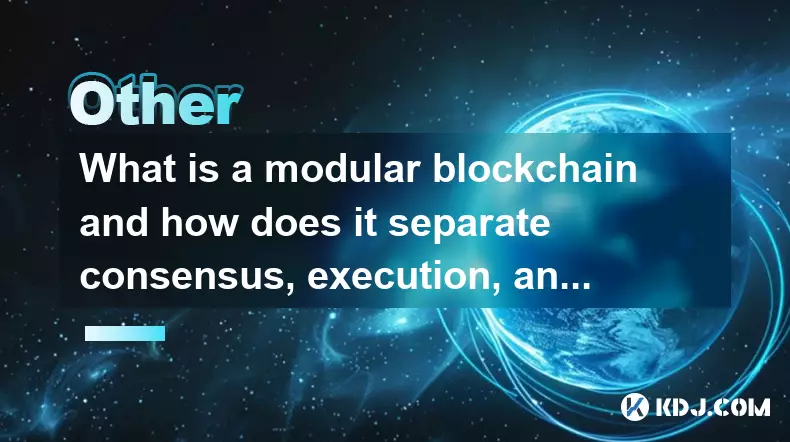-
 bitcoin
bitcoin $99296.318777 USD
-2.82% -
 ethereum
ethereum $3203.465899 USD
-6.84% -
 tether
tether $0.999590 USD
-0.03% -
 xrp
xrp $2.308913 USD
-4.00% -
 bnb
bnb $922.788929 USD
-3.53% -
 solana
solana $144.020807 USD
-5.89% -
 usd-coin
usd-coin $0.999798 USD
0.00% -
 tron
tron $0.291590 USD
-1.12% -
 dogecoin
dogecoin $0.163780 USD
-4.46% -
 cardano
cardano $0.526919 USD
-4.40% -
 hyperliquid
hyperliquid $37.888865 USD
-2.24% -
 bitcoin-cash
bitcoin-cash $510.515457 USD
-1.08% -
 chainlink
chainlink $14.436987 USD
-5.63% -
 stellar
stellar $0.267345 USD
-4.77% -
 unus-sed-leo
unus-sed-leo $9.175222 USD
0.53%
What is a modular blockchain and how does it separate consensus, execution, and data?
Modular blockchains split core functions like consensus, execution, and data availability into specialized layers, boosting scalability, security, and innovation across decentralized networks.
Nov 11, 2025 at 10:19 pm

Understanding Modular Blockchain Architecture
1. A modular blockchain is a design approach that breaks down the core functions of a blockchain into distinct, interoperable layers. Unlike traditional monolithic blockchains like Bitcoin or Ethereum, where all operations occur on a single chain, modular systems assign specific tasks to specialized components. This separation enhances scalability, flexibility, and efficiency across the network.
2. The primary functions typically decoupled in a modular setup are consensus, execution, and data availability. Each of these components can be optimized independently, allowing developers to upgrade or replace one layer without disrupting the entire system. This modularity supports innovation and faster iteration cycles within the ecosystem.
3. By isolating functionality, modular blockchains enable rollups and other scaling solutions to operate more efficiently. Instead of forcing every node to process every transaction, the workload is distributed. Execution happens off-chain, while consensus and data verification remain secured by the base layer.
4. This architecture allows for greater customization. Different applications can choose their preferred execution environment while still relying on a shared, secure consensus mechanism. Projects such as Celestia, EigenLayer, and Arbitrum exemplify various implementations of this model.
5. Modular designs reduce bottlenecks by enabling parallel processing and targeted upgrades, making them ideal for high-throughput decentralized applications.
Decoupling Consensus from Execution
1. In a monolithic blockchain, nodes both validate transactions (execution) and agree on the state (consensus). This tight coupling limits performance because every node must replicate all work. Modular blockchains separate these roles: some nodes handle transaction processing, while others focus solely on validating the order and correctness of blocks.
2. Execution environments, such as optimistic or zk-rollups, process transactions independently and submit results to a consensus layer. The base chain does not execute the transactions but ensures that the proposed state transitions follow the rules. This reduces computational load on the main network.
3. Rollup operators batch hundreds of transactions off-chain and post compressed proofs or summaries to the consensus layer. Validators on the base layer verify these inputs without re-executing them, drastically improving throughput and lowering fees.
4. This division allows execution layers to innovate freely—using different virtual machines or programming languages—while inheriting security from the underlying consensus mechanism.
5. For example, Ethereum serves as a consensus and data availability layer for many rollups, which handle execution. This setup leverages Ethereum’s decentralization and security while delegating computation to more efficient systems.
Isolating Data Availability
1. Data availability refers to the assurance that transaction data is published and accessible for verification. In modular blockchains, this function is often separated from both consensus and execution. Without guaranteed data availability, validators cannot audit state transitions, opening the door to censorship or fraud.
2. Some networks use data availability sampling (DAS), where light clients randomly sample parts of a block to confirm its availability without downloading the full dataset. This technique scales validation across thousands of nodes efficiently, even with limited bandwidth.
3. Dedicated data availability layers, like Celestia, publish raw transaction data and allow independent execution engines to pull from it. These layers do not process transactions themselves but ensure that all necessary information is publicly stored and retrievable.
4. When rollups post transaction data to a data availability layer, they enable trustless bridging and fraud detection. Anyone can reconstruct the state if needed, preserving decentralization and transparency.
5. By externalizing data availability, modular chains prevent centralization risks associated with opaque or restricted data access, reinforcing user sovereignty.
Frequently Asked Questions
What problem does modular blockchain solve?Modular blockchains address scalability and inflexibility in traditional systems. By splitting responsibilities across layers, they allow higher transaction throughput, lower costs, and easier upgrades compared to monolithic designs that bottleneck at the chain level.
How do rollups benefit from modular architecture?Rollups leverage modular blockchains by offloading execution while relying on the base layer for consensus and data availability. This enables faster processing and reduced gas fees, with security maintained through cryptographic proofs and decentralized verification.
Can a modular blockchain be less secure than a monolithic one?Security depends on implementation. If the consensus and data availability layers are robust and decentralized, modular systems can be equally or more secure. However, reliance on external layers introduces new trust assumptions that must be carefully managed through economic incentives and cryptography.
Which projects are leading in modular blockchain development?Celestia focuses on data availability, Ethereum acts as a settlement and consensus layer for rollups, and EigenLayer enables restaking for securing modular components. Together, these projects form the foundation of the emerging modular stack in crypto infrastructure.
Disclaimer:info@kdj.com
The information provided is not trading advice. kdj.com does not assume any responsibility for any investments made based on the information provided in this article. Cryptocurrencies are highly volatile and it is highly recommended that you invest with caution after thorough research!
If you believe that the content used on this website infringes your copyright, please contact us immediately (info@kdj.com) and we will delete it promptly.
- Crypto Carnage: Navigating Selling and Liquidations in a Wild Market
- 2025-11-14 16:50:01
- Mohammed Siraj's First Spell Woes: An India Teammate's Critique
- 2025-11-14 14:40:02
- BTC, ETH, and Altcoin Picks: Navigating the Crypto Landscape
- 2025-11-14 14:50:01
- Coin Toss Tales: Temba Bavuma's Wager and India vs. SA Showdown
- 2025-11-14 12:50:01
- Shubman Gill, WTC Final, and the Coin Toss: A New Yorker's Take
- 2025-11-14 15:05:01
- Aerodrome Takes Flight: Unifying Ethereum DeFi Liquidity Across Chains
- 2025-11-14 15:10:02
Related knowledge

What is the difference between a blockchain and a distributed ledger technology (DLT)?
Nov 14,2025 at 08:59pm
Understanding the Core Structure of Blockchain and DLT1. A blockchain is a specific type of distributed ledger technology that organizes data into blo...

How does a blockchain handle data storage?
Nov 14,2025 at 04:40pm
Understanding Blockchain Data Structure1. A blockchain stores data in sequential blocks, each containing a list of transactions or records. These bloc...

What are the risks of investing in blockchain projects?
Nov 14,2025 at 10:19am
Risks Associated with Volatility in Cryptocurrency Markets1. The price of digital assets can shift dramatically within minutes due to speculation, new...

What is the role of blockchain in creating a circular economy?
Nov 15,2025 at 02:19am
Enhancing Transparency in Supply Chains1. Blockchain technology provides an immutable ledger that records every transaction across supply chains, ensu...

How can blockchain technology be used in healthcare?
Nov 14,2025 at 07:39pm
Secure Patient Data Management1. Blockchain enables decentralized storage of medical records, ensuring patients maintain control over who accesses the...

How does blockchain impact the future of voting systems?
Nov 14,2025 at 10:00pm
Enhanced Security in Digital Voting Through Blockchain1. Blockchain technology introduces cryptographic hashing that ensures each vote is immutable on...

What is the difference between a blockchain and a distributed ledger technology (DLT)?
Nov 14,2025 at 08:59pm
Understanding the Core Structure of Blockchain and DLT1. A blockchain is a specific type of distributed ledger technology that organizes data into blo...

How does a blockchain handle data storage?
Nov 14,2025 at 04:40pm
Understanding Blockchain Data Structure1. A blockchain stores data in sequential blocks, each containing a list of transactions or records. These bloc...

What are the risks of investing in blockchain projects?
Nov 14,2025 at 10:19am
Risks Associated with Volatility in Cryptocurrency Markets1. The price of digital assets can shift dramatically within minutes due to speculation, new...

What is the role of blockchain in creating a circular economy?
Nov 15,2025 at 02:19am
Enhancing Transparency in Supply Chains1. Blockchain technology provides an immutable ledger that records every transaction across supply chains, ensu...

How can blockchain technology be used in healthcare?
Nov 14,2025 at 07:39pm
Secure Patient Data Management1. Blockchain enables decentralized storage of medical records, ensuring patients maintain control over who accesses the...

How does blockchain impact the future of voting systems?
Nov 14,2025 at 10:00pm
Enhanced Security in Digital Voting Through Blockchain1. Blockchain technology introduces cryptographic hashing that ensures each vote is immutable on...
See all articles










































































